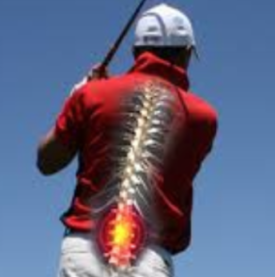 Even though golf is a low-impact sport, it is associated with a considerable number of injuries. Many injuries related to golf are the product of a deficient body mechanics or an overload. The part that is injured most frequently is the lumbar region, followed by the elbow, the wrist and hand, then the shoulders.
Even though golf is a low-impact sport, it is associated with a considerable number of injuries. Many injuries related to golf are the product of a deficient body mechanics or an overload. The part that is injured most frequently is the lumbar region, followed by the elbow, the wrist and hand, then the shoulders.
Follow this advice to keep in form on the golf course.
The golf swing is a complex coordinated movement that involves the whole body. Frequent repetition of this movement may have a considerable impact on the muscles, tendons and joints. Over time, it may cause an injury.
Understanding the mechanics of the golf swing may help you to avoid injuries caused by this sport. Attempt to follow this advice:
● Adopt the correct posture. Stand with your feet apart in line with the width of your shoulders and with a slight rotation outwards, flexing your knees a little. Keep your backbone relatively straight and lean your torso forwards; but the main impetus of the movement should come from your hips. Avoid bending over the ball, as this may make your neck and back tense.
● Keep the movement fluid. The power of the golf swing comes from a force that, quite fluidly, is transmitted to all the muscle groups, from the ankles to the wrists. If you depend upon a single area of your body for the strength of the shot, you will be more vulnerable to suffer injury. For example, forcing the wrists during the shot can cause an injury known as «golfer’s elbow», which happens when the muscles on the inner part of the forearm are tensed.
● Don’t overdo the movement. If you swing the golf club very hard or very fast, you can force your joints. Relax and hit the ball gently and smoothly. When they make their swing, the best golf players have a uniform rhythm, not necessarily very rapid.
Further advice to keep your goal in sight.
The golf swing is only a part of this sport. Bear in mind other ways of reducing the risk of injuries caused by golf:
● Do warm-up exercises. Before practising your swing or playing a game of golf, do warm-up exercises for al least 10 minutes, such as a brisk walk or some jumping jacks. Stretch your hands, wrists, forearms, elbows, shoulders, back and pelvis. Swing the golf club a few times, gradually widening the movement.
● A gentle start. You may begin by practising your swing for hours, believing that it will help you in your game. But if your body is not prepared for this effort, the repetitive practice of the golf swing can cause you more harm than good.
● It is better to gradually build up your exercise until you reach your desired level.
● Fortify your muscles. You don’t need huge muscles to achieve a long drive; but the stronger your muscles, the faster the golf club will go. Also, stronger muscles are less vulnerable to injury. To achieve the best results, do exercises to fortify your muscles all year long.
● Concentrate on your flexibility. Regular stretching can improve your breadth of movement and give a smoother swing.
● Build up your resistence. Regular aerobic exercises can give you resistence for your performance on the green. Try to walk, jog, cycle or swim.
● Take care when lifting and carrying your clubs. Golfers who carry their own bags are more likely to suffer injury to their shoulders or back compared to other golfers. If you pull heavy clubs out of your car boot carelessly, you can have done yourself an injury even before you get to the first tee. Employ a technique suitable for lifting weights: keep your back straight and use the strength of your legs to lift the weight.
● Try not to hit any other object but the golf ball. If you hit the ground or the rough, this can cause injuries in the elbows and wrists.
● Choose the right footwear. Wear comfortable clothes that keep you warm and dry. Wear golf shoes with low plugs. High plugs stick in the green and stop your foot from moving during the swing, which can force the knees or ankles.
Sources. Mayo Clinic / HC Marbella Traumatology Service.
April 9, 2019
Read other news
Tel.: +34 952 908 628
+34 609 148 799
952908898 Oncology
951829978 Diagnosis by imaging
951829947 Gynecology
952908897 Fertility
951829947 Physiotherapy